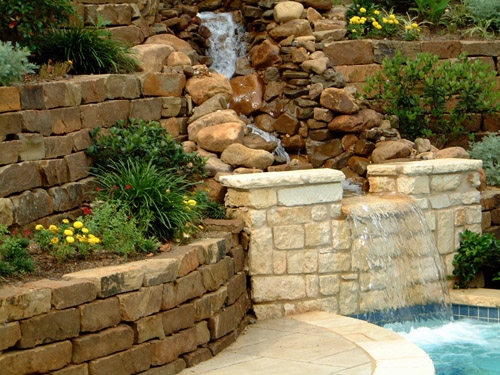Have you decided to roll up your sleeves, grab your gloves and get started building a stack retaining wall?
Stack walls can be a great choice when you are designing raised beds in your garden, preventing mild soil erosion or defining landscaping boundaries on hills. Typically made up of rows of traditional cinderblocks or decorative stacked stone placed on top of one another, this style of retaining wall is visually appealing and can be done without professional installation or permits when they are lower than 3 feet high and are not being used as structural support for footings and foundations of homes or buildings.
Here are the five common mistakes to avoid when building:
1. Don’t use the wrong size of cinderblock to build your wall. Make sure the dimensions of your blocks are proportionate to the amount of soil they will retain. Garden or accent walls less than 3′ high can be built with standard-sized blocks about 12″ long x 4″ high. Walls built over 3′ high or walls holding back a substantial amount of earth require full-size cinder blocks, typically 16″ long x 8″ deep/thick. Decorative blocks for retaining walls can weigh up to 100 lbs and can withstand the soil pressure behind them. Pressure from soil and water is an exponential problem as the wall gets taller, so getting the size of blocks right is critical to prevent the wall from blowing out or failing. We recommend working with professionals for structural retaining walls of this size because excavation and moving of tons of soil are required, as well as permitting with city inspectors. Soil and design engineering is required at this level and it is best to put the wall’s structural integrity in the hands of licensed contractors.
2. Don’t skip installing geotextile fabric behind stack walls. Spun geotextile fabric is a permeable material used to stabilize the back soil, help with water drainage and erosion control. If your wall is built without geotex fabric, the back soil is going to settle into the wall, causing sinkage of adjacent soil. This can cause water flow to be directed toward the wall, causing soil erosion. Eventually, the wall could blow out.
3. Don’t forget drainage! Retaining walls require proper water drainage systems to prevent water pressure build-up. Without drainage, the pressure can cause bulging, separating, cracking and eventually, collapse. The higher the wall, the more important your drainage systems are. The back of your wall should be lined with geotextile fabric and then backfilled with stone allowing drainage. Good drainage stone is typically gravel, about 3/4″ in size. Weep holes should be placed about every 16″ apart. The California Contractors State License Board requires the contractor to install weep holes whether a retaining wall appears to need them or not, so it is always a best practice to place these in the wall as you build.
4. Don’t overpay for your materials. Hit up home improvement stores like Home Depot for great prices on standard cinder blocks. Because of their popularity, standard cinder blocks are purchased in high volume at bulk prices and offered to customers at a great rate. For stack stone walls contact your local building material company for good prices, as these businesses buy in bulk and can usually offer lower material and delivery prices than your local home improvement store.
5. Don’t end up in the emergency room by not taking practical safety measures. Gloves can save your fingernails from breaking under a dropped stone, and proper lifting techniques are a must. Use proper bracing by not bending at the waist, not lifting over your shoulder, and not twisting your body when lifting or holding heavy stones. A team of two to five people working together will optimize the amount of time it takes to build the wall and also help to minimize the safety hazards.
Bottom Line
Building your own stack wall for garden boundaries, planters, and landscape accents can be a fun and rewarding DIY project. Any wall over 3 feet high or with structural support requirements should be handled professionally, with proper materials, structure, and safety measures in mind.



